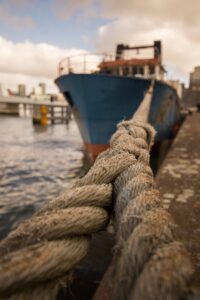
SOLAS Regulation 11-1/3-8 will come into effect from 1 January 2024. IMO had issued IMO issued the MSC.1/Circ.1619 in December 2020, which included updated revised rules on the design of mooring arrangements and the selection of appropriate mooring equipment and fittings for safe anchoring. To complement the new regulations, the MSC.1 Circ. 1620 Guidelines for inspection and maintenance of mooring equipment, including lines and MSc.1 Circ. 1175/Rev.1 have been issued/renewed. The amendments listed above apply to ships built after January 1, 2024. Tankers, on the other hand, have been in compliance with these criteria since July 2018, when the new OCIMF MEG-4 rules came into effect.
It is important to note that for ships built prior to 1 January 2024, the previous version of MSC.1 Circ.1175 remains the applicable standard for construction items (MBL, SWL, etc). However, these ships should also conform to inspection /maintenance requirements as per Circ. 1620.
What are the Changes
The amended materials include new words and definitions, important one are reproduced below. The majority of them are consistent with OCIMF MEG-4.
Ship Design Minimum Breaking Load (MBLSD):
The minimum breaking load of new, dry mooring lines for which shipboard fittings and supporting hull components are designed to meet mooring restraint standards is called the ship design minimum breaking load (MBLSD). This is a critical parameter since it determines the forces exerted by other factors during anchoring. For mooring arrangements the Safe Working Load should be equal to or greater than the MBLSD.
Line Design Break Force (LDBF):
Line Design Break Force (LDBF) is the force at which a fresh, dry, spliced mooring line will break. This is applicable to all synthetic cordage materials. This should be limited to a maximum of 105% of MBLSD.
Mooring area:
A mooring area is a specific area aboard a ship where mooring equipment is mounted and line-handling occurs. It also includes regions where there is a risk of crew injury in the event of mooring equipment snap-back or other failure. A ship may have many mooring sites.
Mooring arrangements:
Mooring arrangements refer to the configuration of mooring equipment and fittings, as well as other ship design aspects connected to mooring operations, such as illumination and communication equipment.
Mooring equipment and fittings:
Mooring equipment and fittings include mooring winches, capstans, bollards, bitts, fairleads, rollers, chocks, and so on, as well as mooring lines.
Mooring lines:
Other than messenger lines, mooring lines include ropes, wires, and combinations utilised for mooring operations.
Mooring line configuration:
Mooring line configuration refers to all components of a single mooring line, such as tails, eye splices, and so on. Unless a component is replaced by a part with the same specifications as in the original configuration, any change or replacement of a component represents a change to the line’s configuration.
Working Load Limit (WLL):
The maximum load that a mooring line should be subjected to in operational service, computed from the applicable environmental mooring constraint requirement, is called the Working Load Limit (WLL).
The revised circulars focus on the two (2) main components of mooring lines. The building phase, which takes into account the strength of the lines, occurs first. The second stage entails inspecting and maintaining all fittings, lines, and machinery.
MSC.1 Circ.1175, till now, presented a list based on computed Equipment Number (EN), which indicated the strength of the lines used on board based on specific environmental circumstances, side projecting area. The number of lines was determined using IACS Rec.10 and the ship’s side projecting area. In both situations, the projecting area was computed using heights measured from the Summer Load Water line.
The following differences exist in the amended MSC1. Circ. 1175 Rev.1:
-
- The IACS rec.10 regarding the number of mooring lines to be used has been incorporated.
-
- The strength of mooring lines to be utilised is still determined for ships having EN 2000, but for EN >2000, the calculation of hull side projecting is performed using the lightest ballast draught.
MBLSD = 0.1 *A1 + 350 in kN is the formula for calculating line strength.
A1 is the side projecting area estimated according to Appendix B of the circular, with the previously specified deviations.
